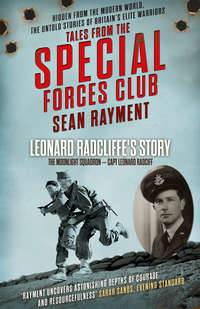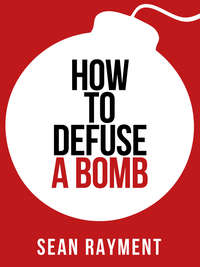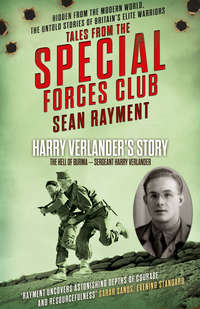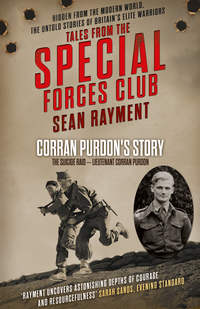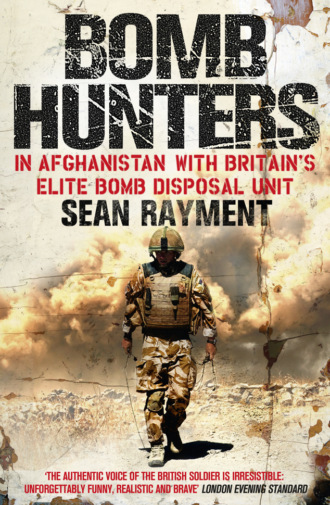
Полная версия
Bomb Hunters: In Afghanistan with Britain’s Elite Bomb Disposal Unit

BOMB HUNTERS
IN AFGHANISTAN WITH BRITAIN’S
ELITE BOMB DISPOSAL UNIT
SEAN RAYMENT


Copyright
Collins
An imprint of HarperCollinsPublishers Ltd. 1 London Bridge Street London SE1 9GF
www.harpercollins.co.uk
Text © Sean Rayment 2011
Sean Rayment asserts his moral right to be identified as the author of this work
All photographs © Heathcliff O’Malley, see the individual images for exceptions.
While every effort has been made to trace the owners of copyright material reproduced herein, the publishers would like to apologise for any omissions and will be pleased to incorporate missing acknowledgements in any future editions.
A catalogue record for this book is available from the British Library
All rights reserved under International and Pan-American Copyright Conventions. By payment of the required fees, you have been granted the nonexclusive, nontransferable right to access and read the text of this ebook on-screen. No part of this text may be reproduced, transmitted, downloaded, decompiled, reverse-engineered, or stored in or introduced into any information storage and retrieval system, in any form or by any means, whether electronic or mechanical, now known or hereinafter invented, without the express written permission of HarperCollins ebooks
HarperCollinsPublishers has made every reasonable effort to ensure that any picture content and written content in this ebook has been included or removed in accordance with the contractual and technological constraints in operation at the time of publication
Source ISBN: 9780007374786
Ebook Edition © 2011 ISBN: 9780007413256
Version: 2017-09-06
In memory of all of those who have taken the long walk and never returned.
Dedicated to Josephine Rayment
Contents
Cover
Title Page
Copyright
Prologue
Chapter 1: Living the Dream
Chapter 2: Badger’s War
Chapter 3: Bomb Makers
Chapter 4: The Front Line
Chapter 5: The Asymmetric War
Chapter 6: The Lonely Walk
Chapter 7: Murder at Blue 25
Chapter 8: New Arrivals
Chapter 9: The Battle of Crossing Point One
Chapter 10: Going Home
Epilogue
Images of the Bomb Hunters in Action
Keep Reading
Appendix
Glossary
Index
Acknowledgements
About the Author
About the Publisher
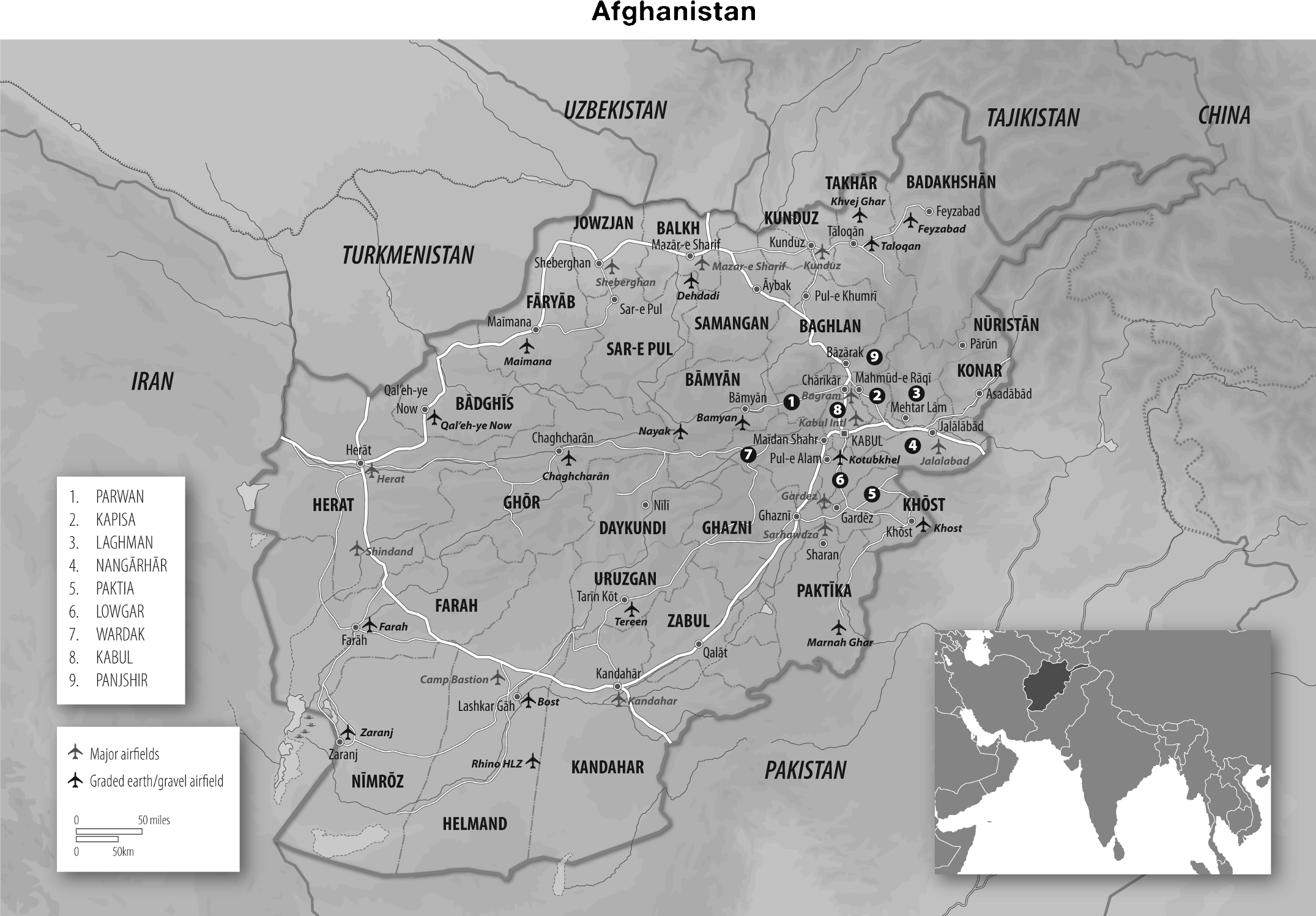
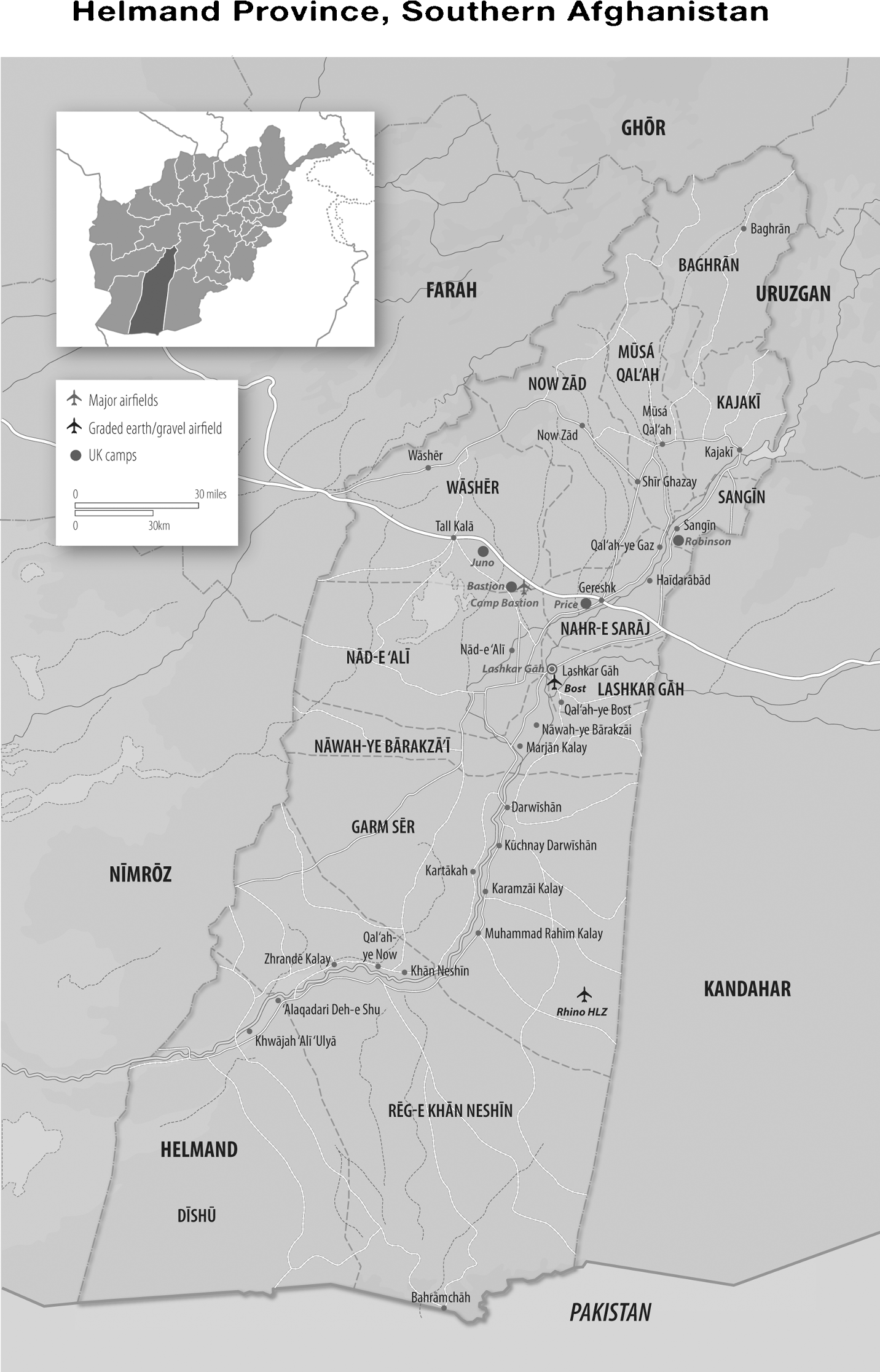
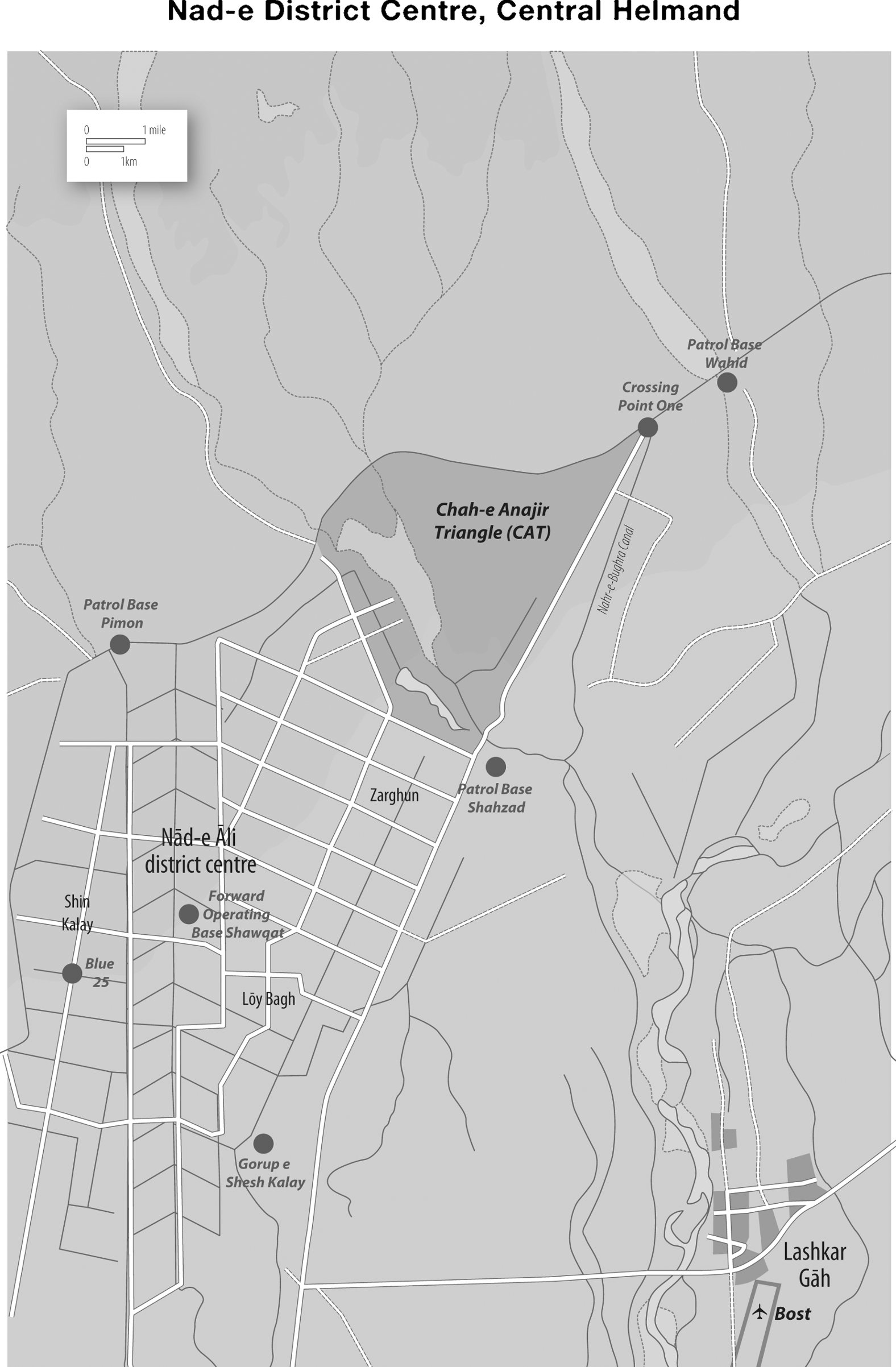
Prologue
0500 hours, 16 August 2009, Sangin.
The point man swung his mine detector and listened for the high-pitched alarm before taking a step. The sun had yet to rise from beneath the horizon and the Green Zone, fed by the waters of the Helmand River, was still cool and damp and a friend to the soldiers. Silence. That was good – it was the sound he wanted to hear as he continued his slow, probing search along the dried river bed.
Swing, step, listen. Swing, step, listen.
Lance Corporal James ‘Fully’ Fullarton was commander of the point section – the loneliest job in Helmand. Stretched out behind him in a silent, human chain were 130 men of A Company, 2 Rifles, each literally trying to follow in Fully’s footsteps as he steered his way through the Taliban killing fields surrounding the British base.
Fully was good at his job, probably the best point man in the company. He had lost count of the number of patrols he had undertaken since arriving in Helmand five months ago. He had seen and done it all in Helmand. Now he had just one more month to push and then it was back home to his fiancée. Two months earlier, while on R&R, he had popped the question and Leanne, the love of his life, had said yes. The couple were planning to marry the following year.
Strong as an ox and with a ready smile, 24-year-old Fully was undaunted by the knowledge that he alone was charged with picking a safe route through one of the most dangerous and mine-ridden areas of Helmand. He had grown used to the surge of fear that rose up from his stomach every time he left his base in Sangin for another operation into the Taliban badlands. He had learned to live with the terror of knowing that one step in the wrong place could mean instant death or mutilation.
In Afghan, as the soldiers call it, it was good to be scared. Being scared meant you cared, about yourself and mates. Fear heightened the senses and challenged complacency. Fear kept you alive.
Step, swing, listen. Step, swing, listen.
Fully always insisted that the next man in the patrol keep at least 15 ft behind him – close enough to hear the whispered words of command, but hopefully far enough away to avoid being fragged if Fully stepped on a pressure-plate IED, the Taliban’s weapon of choice in the Sangin Valley.
The pre-dawn mission on that late-summer morning was intended to clear a route south-west of Sangin town. Several of the soldiers had been physically sick while waiting for the order to move out from the secure surroundings of Forward Operating Base (FOB) Robinson, a fortified compound rumoured to have once belonged to an Afghan drug lord. Others traded banter but the majority were silent, hoping that today it would not be their wife, mother or father who got the knock on the door with the news that their husband or son had fallen victim to a Taliban bomb.
It was a dangerous mission and everyone knew it. Fully’s section of eight men from 2nd Battalion Royal Regiment of Fusiliers, attached to the Rifles as vital reinforcements, were at the vanguard of the operation. The soldiers solemnly filed out of the base into the early-morning darkness. No one spoke; only the soft crump of boot steps walking through the talcum-like dust could be heard. After just a few hundred metres many of the soldiers, weighed down by ammunition, water, and radios, were breathing heavily, their desert-camouflage uniform clinging to sweat-soaked bodies.
Fully knew the route well and had little trouble navigating his team across the cold waters of the waist-deep Helmand River and into the wadi that lay beyond. As the commander of the point section Fully also had to scout ahead, searching the shadows and the reed banks for any sign of the enemy.
Step, swing, listen. Step, swing, listen.
No one knows whether Fully heard the tiny click as the two plates forming the conducting elements of the low-metal pressure plate touched. But even if he did, there was no time to react. The circuit was made in an instant, electricity flowed, and the detonator buried inside 20 kg of home-made bomb exploded. The blast tossed Fully 40 ft through the air in a sudden, violent explosion, and when he landed his legs had gone.
Staff Sergeant Kim Hughes, a bomb-disposal expert, took cover as the sound of the explosion rumbled along the valley. A thick brown plume of smoke and dust mushroomed into the lightening Helmand sky.
‘Fuck. IED,’ he involuntarily muttered under his breath. After four months in Helmand during which time he had neutralized eighty bombs, Staff Sergeant Hughes could tell the difference between the sound of home-made and conventional explosives detonating. A shiver ran down his spine.
Brimstone 30 – the callsign, or radio codename, of the bomb-hunting team led by Staff Sergeant Hughes – had been attached to the company to provide support in case IEDs were discovered during the operation. The team was composed of the IED disposal team and a Royal Engineer Search Team, or REST. Without prompting, the searchers began preparing for action. Two minutes later they were called forward to begin clearing an emergency HLS, or helicopter landing site, and only then did they know that a casualty had been taken.
Up ahead, at the scene of the explosion, a form of controlled panic had descended. Fully was lying motionless, having sustained terrible injuries. Fusiliers Louis Carter, 18, and Simon Annis, 22, two of Fully’s best mates, soldiers who had become closer than brothers, inched their way towards their stricken commander. Their faces filled with horror as they saw the extent of his injuries. Fully was alive, just.
An urgent message was sent back to battalion headquarters. ‘Contact! IED strike. We have one double amputee, wait out.’
‘Don’t worry, Fully, we’re gonna get you out, mate. Everything will be OK,’ said Fusilier Annis as the soldiers lifted Fully’s shattered body onto a stretcher. Tourniquets were applied to stem the flow of blood from his wounds. Morphine helped to dull the pain. The two soldiers lifted the stretcher and were moving as quickly as possibly towards the HLS when a medic saw that Fully had stopped breathing. ‘Come on Fully, mate, breathe,’ cried Fusilier Annis.
They were the last words he spoke.
With Fully revived, the stretcher bearers moved off again and almost immediately detonated another massive IED. Fusiliers Carter and Annis were killed instantly. Then the screaming started.
‘What the fuck’s going on?’ said Sergeant Pete Ward, as the distant sounds of panic grew louder.
‘God knows,’ replied Staff Sergeant Hughes, ‘but it’s bad.’
Sergeant Ward was a Royal Engineer Search Advisor, or RESA, and a key member of Brimstone 20. The two men looked at each other but no one spoke. It was a silent confirmation that the worst had just happened.
The men readied themselves for action. Staff Sergeant Hughes checked his equipment. He made sure his snips – wire-cutters – were tucked securely into the front of his body armour, next to his paint-brush and hand-held mine detector. The rest of his essential equipment was contained in his man bag. Their preparations were interrupted by a red-faced fusilier who emerged out of the gloom with the unmistakable look of fear etched across his youthful face. ‘We need the search team up ahead,’ he stuttered. ‘We’ve got multiple casualties.’
Staff Sergeant Hughes swallowed hard, turned to his colleague, and said, ‘Pete, be careful. We don’t know what we’ve got up there.’
Forty-eight hours earlier Hughes had been enjoying the last few hours of his R&R back in his home town of Telford. He and his team of bomb hunters were due to form the High Readiness Force (HRF) back at Camp Bastion for at least a week as they reacclimatized to the Helmand summer. But then his close friend Staff Sergeant Olaf Schmid and his team had been stricken by a bout of diarrhoea and vomiting and were pulled out just before the operation, which meant Brimstone 20 were sent instead.
Hughes gathered his team together for a final briefing. ‘Fuck knows what’s going on but it doesn’t look good. Everyone stay sharp.’ Turning to one of the searchers who had remained with his team, he said, ‘We don’t know if anything has been missed, so I want you to clear a route up to the incident. Stop about 30 metres short of where the injured are and we’ll make an assessment. Everybody move in single file and stay switched on.’
The reeds on either side of the bank grew taller and thicker farther along the river bed and channelled the screams of the injured back towards the bomb hunters. As they moved closer to the scene of carnage, they began to pass soldiers sitting on their haunches or crouching in fire positions. Some had been crying. Others stared blankly into the distance. The look of abject terror on their faces told its own story.
The lead searcher stopped and Hughes moved up to his side. Neither man spoke. Searchers were slowly clearing safe lanes to the dead and injured. Beads of sweat ran down the staff sergeant’s face and he breathed heavily as he took in the enormity of the devastation. The dead and injured – some six soldiers – were spread over an area of 200 square metres. Uninjured soldiers were also trapped inside what was effectively a minefield. They too would also need to be freed. In the distance the sound of uncontrolled sobbing could be heard. Only the searchers were moving, their silent concentration broken by words of encouragement for the wounded.
The body closest to where Hughes was standing had no legs and only one arm. On the other side of the bomb crater lay another soldier, clearly dead, his legs gone. The two soldiers had been blown about 20 metres in opposite directions and so Hughes knew from experience that it was a device composed of 20–30 kg of HME, home-made explosive. For the first time in his career as a bomb hunter Staff Sergeant Hughes was confronted with a mass-casualty IED incident.
He willed himself not to be distracted by the screams of the female medic whose leg was snapped in two by the force of the second blast. Loitering menacingly at the back of his mind was the death of Captain Dan Shepherd, a bomb-disposal expert killed while on operations three weeks earlier.
Now was the time to concentrate, to formulate a plan, to try to work out what the hell was going on. The size and positions of the two explosions told him that the bombs must have been wired up to a central power source. But where was it? The injured were the priority, the dead would be collected later: it was always the same routine. But the key now was to ensure there were no more casualties. One of the searchers had cleared a safe route, searching the ground almost inch by inch, to the injured female soldier when he discovered another device. ‘Got one, Kim.’ The device was about an arm’s reach away from where the injured medic was lying.
Time was now crucial. Everyone knew the Taliban would be moving towards the sound of the explosion and hoping to ambush the casualty evacuation. There was no time to put in a protective cordon, use remote vehicles, or for Hughes to don his protective bomb suit. It was a Category A action, a practice only conducted in one of two circumstances: either a hostage scenario where explosives have been strapped to an innocent individual, or a mass-casualty event where not taking action is certain to result in further casualties.
In both situations the emphasis is on saving other people’s lives even at the expense of the operator. Staff Sergeant Hughes knew what had to be done. Take the power source out of the equation, he thought to himself. He began a fingertip search up to where he believed the first bomb had been buried, locating first the pressure plate and then the 20 kg bomb itself. As he searched he told the young woman that she was going to be fine, urging her to remain calm. He found a wire and cut it, all the time hoping that the Taliban hadn’t upped the ante and created a collapsing circuit. If they had he knew he would be dead in seconds. But there was no bang.
Even before completing the neutralization, a searcher located another device between Fully, who was still alive, and the Royal Military Police soldier, who was lying on the ground writhing in agony. As Hughes cleared a route to the device, a wire leading into the areas where the bombs had been placed had been discovered. There was every possibility that the recovery operation was now being targeted by a hidden insurgent.
The searchers had to accept that any further devices could contain little if any metal and as such they could no longer rely on their mine detectors. By now the sun was starting to rise in the sky and the bomb hunters were warned by intelligence officers from the battle-group headquarters that the Taliban were moving into the area. Staff Sergeant Hughes pushed on to the next device. Once again it was a pressure-plate, or victim-operated IED (VOIED), linked to what was a central power source. It immediately struck Hughes that he was dealing with a complex device not seen in Helmand before. He was now in a whole new dangerous world with only his wits and skill to rely on. All the bombs were laid out in exactly the same way and were composed of a pressure-plate IED which sat directly on top of a 20 kg main charge of explosive. There was every possibility that if one bomb detonated they would all explode at the same time.
Again Hughes conducted a Cat A neutralization, and again any error would have proven fatal. Less than two minutes after the second device had been neutralized a third was discovered near one of the dead soldiers. The device was located on the extraction route over which the casualties would have to pass. For the third time in less than twenty minutes Hughes carried out a Cat A task.
As the sun began to illuminate the wadi, dark patches of disturbed soil could be seen all around. Hidden beneath each site was a bomb. In an area of 40 metres by 50 metres the bomb hunters found seven bombs. In addition they identified the locations of another six devices from ‘ground sign’, disturbed earth left after a bomber has planted a device, and left these in situ.
Hughes was moving back along one of the cleared routes close to where a fallen soldier lay when a platoon sergeant asked him to remove the soldier’s dog tags. The soldier had sustained a triple amputation and his face was covered in severe lacerations. Hughes rolled the dead soldier onto his front and pulled out the two dog tags from beneath his body armour. He took one off, threw it to the platoon sergeant, and put the other back securely on the dead soldier so that he could be formally identified later. He rolled the body back into its original position and gave him a comforting pat on the back.
Before the wounded could be evacuated, two more devices which had been discovered on the extraction route needed to be neutralized.
Despite the carnage, Hughes managed to maintain his composure until a stretcher party arrived to collect the bodies. It was clear that one of the young soldiers on the team had been good friends with at least one of the dead. The fusilier began to sob uncontrollably when he saw his friend lying dead in the dust of the dried river. Suddenly the full enormity of what had happened began to dawn on everyone involved in the operation. Up until that point Staff Sergeant Hughes and his team had been wholly concentrating on locating and neutralizing Taliban bombs. His focus broken, he turned away, his eyes welling up with tears. No one spoke. The bomb hunters hung their heads as the young soldier was carried away. Everyone knew there were many more tears to come.
Just forty-five minutes after Hughes arrived at the scene, more than a dozen devices had been located and seven had been cleared, five by a Cat A action. After the bombs were neutralized, the injured and dead were removed. Fully didn’t make it – his injuries were too severe. The three other wounded soldiers all recovered. The team didn’t know it at the time but they had just completed what was later described as the single most outstanding act of explosive ordnance disposal ever recorded in Afghanistan, for which Staff Sergeant Hughes was later awarded the George Cross. By the end of his six-month tour he had cleared 118 bombs.
Конец ознакомительного фрагмента.
Текст предоставлен ООО «ЛитРес».
Прочитайте эту книгу целиком, купив полную легальную версию на ЛитРес.
Безопасно оплатить книгу можно банковской картой Visa, MasterCard, Maestro, со счета мобильного телефона, с платежного терминала, в салоне МТС или Связной, через PayPal, WebMoney, Яндекс.Деньги, QIWI Кошелек, бонусными картами или другим удобным Вам способом.






